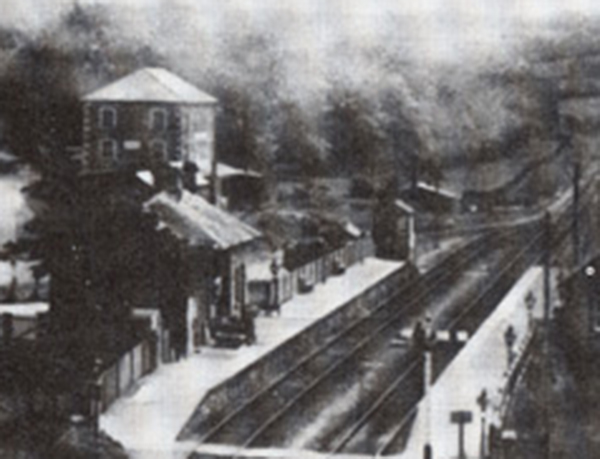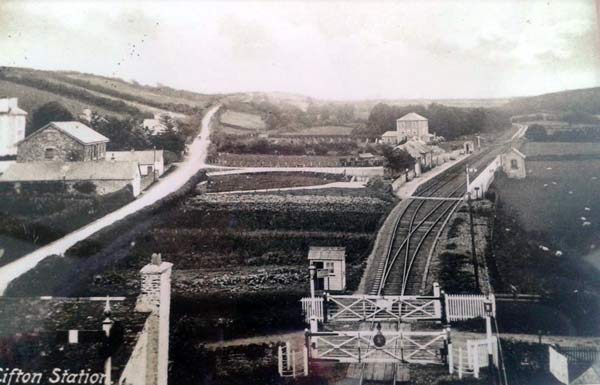.

The original Lifton Roller Mill (Spry Mill) was destroyed by flooding and its replacement building burnt down after a disastrous fire in 1881. Again rebuilt, the building was to suffer two more devastating fires one in 1887 and another in 1893. After this last fire the mill was rebuilt on a site about 80 yards from the original so as to secure greater facilities for the way the motive power – water – may be used. There was a complicated aqueduct to bring the water from the leat to the mill where it fed overshot wheels, later to be replaced by two turbines. There was a mile and a half of leat from Sprytown on the River Lyd to Spry Mills.
The new building was erected for the then owner, Mr John Bayly, by Mr William Burt, builder, of Launceston, with the machinery being installed by WR Dell & Son, of Mark Lane, London. The new mills then stood adjacent to the Lifton Station, and tracks were run right under the loading platform, therefore saving much haulage and labour, the seven horses previously needed were dispensed with. The motive power was obtained from the River Lyd, a twenty-five feet fall working a turbine of twenty-two inches. This gave from 60 to 70 horse power, and the mill could turn out from three to five bags of perfect flour per hour. The bottom floor was occupied by the main shaft from the turbine, driven by bevel wheels. On the first floor were the double sets of 8 by 24 inches rolls for breaking and reducing the wheat, and three sets of 9 by 18 smooth rolls for the reduction of the middlings to flour. On each floor was a separate chamber for the cleaning process, fitted with modern appliances. There was a grader which separates the wheat into two sizes, the smaller going into a Cockle cylinder and the larger into a barley cylinder. There were a pair of stones for barley grinding, and here also was a gauge for regulating the turbine.
On the third floor are the rotary “scalpers”, and appliances by George Smith & Burnard, for separating the middlings, flour going one side and bran the other. Another cleaning room was on this floor, with warehouse separators for the removal of large foreign matter, and a horizontal machine for finer material, also a Victor brush for polishing the flour. On the top floor were the flour-dressing machines – three of Smith’s centrifugals, two other centrifugals, and three Dell’s improved inter-elevators. Above all were the storage bins.
Briefly, the wheat was unloaded direct from the trucks into the mill, raised by elevators to the top of the mill, and then into the mixers. By these machines six varieties of wheat could be thoroughly mixed in any proportion down to one-twelth, and then sent through the various processes of cleaning and grinding, being finally bagged on the ground floor, and thence at once put on a railway truck.
By 1902 the miller was Samuel Sobey Cole, but for many years the Major family owned the Lifton Roller Mill and it had its own rail siding that can be seen in the photo below. Many of the raw materials used – cottonseed cake, wheat-feed (residue from the milling industry) were all delivered to the siding in 10 or 12 ton wagons mostly in two-cwt hessian sacks, (quite illegal now under HSE rules). Also liquid molasses in tankers discharged by gravity into a large pit directly from the rail line.

These ‘goods’ came mostly from Avonmouth then up from Marsh Mills in Plymouth. They had to be offloaded within 24 hours or the company would have to pay them ‘demurage’ on the wagon – so it was a case of ‘all hands’ on the days when the goods train shunted the trucks to the yard. This was realigned when the Ambrosia factory was built, and then shared.

The Major family sold the business to BG Wyatt, Ltd., of Chard, in about 1963. This was because one of the two Wyatt brothers – Mr Ray Wyatt – decided to leave the business to ‘go farming’. Wyatt’s wanted the business for the flaking plant that made flaked maize (cornflakes) and flaked barley. Wyatt’s then had their own brand ‘Chardex’ that was very popular throughout Devon, Cornwall and Somerset. Up until 1964 the main source of power to the mill was water.
Cornish & Devon Post, 14 Sep. 1878: TO MILLERS: SPRY MILLS, LIFTON, DEVON.
To Be Let, for Fourteen years from Michaelmas next, the Flour & Grist Mill, Dwelling House, Barn, Stable, and Outbuildings, Three Cottages, and about Thirty Acres of Meadow, Orchard, and Arable Land, in the occupation of Mr Ralph Speare, who retires after their successful occupation of 28 years.
The Mill, lately re-built and fitted with new machinery, contains seven pairs of stones, Flour Dressing, Smut, and Flour Machines; Sack and Corn Elevators; and all necessary and convenient Machinery for doing a large Miller’s business. The House is large and convenient, and the Outbuildings are extensive and well arranged. Mr Speare will give the taker the option to purchase his Sacks, Plant, and Implements, at a valuation.
The Lifton Station on the Great Western Railway nearly adjoins, the Mill is about four miles from Launceston, and approached by good roads.
To View – apply at the Mill on any Monday or Tuesday, for further Particulars and Conditions of Letting apply to: Mr Cater, solicitor, Sutton Road, Plymouth.
Cornish & Devon Post, January 28th, 1893. Disastrous Fire at Lifton: Just before midnight, Monday, Launceston residents were awakened by the sound of the fire bell, a message having been received that the Spry Mills, in the occupation of Mr Samuel Cole, were on fire. On arrival the Fire Brigade soon got to work, but it was impossible to save the building, which with contents, was simply burnt out in a few hours. The mill was the property of Mr John Bayly, of Plymouth, and with the machinery, was worth about £2,500, whilst Mr Cole’s share of the machinery and stock represented about the same amount. This is the fourth time the Spry Mills have been destroyed. Many years ago, owing to a heavy flood, the mills was washed away, and the new one which succeeded it was destroyed by fire. It was rebuilt and on April 20th, 1887, was again destroyed by fire.
Since the 1970’s the mill has undergone considerable change with the addition of modern buildings and machinery, whilst at the same time having various owners including Crossfields, Dalgety and today it is owned and worked by Mole Valley Feeds.
Visits: 246
